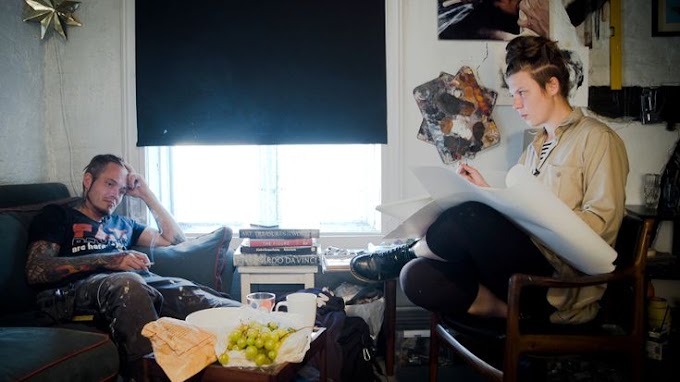Maybe we could meet sometime? Of course, all
for the purpose that I’d love to make a portrait of you.
“Because they were beautiful.”
A Czech hyperrealist painter Barbora Kysilkova paints a Norwegian drug addict criminal named Karl Bertil-Nordland who has just come
out of jail, when she shows the portrait of the criminal to himself, he is stunned with eyes wide open starts to cry like a child, like finally, somebody
sees that he too exists. One of the extraordinary moments of the film.
“Finally, I have been seen.” The director Benjamin Ree filmed this story from 2016 to 2019 with other earlier videos, footage, photographs, and audio recordings. During the filming, his camera becomes so invisible that you constantly remind yourself that there is a cameraman around them, the surreal story and the artistry of the director make it hard to believe that it is not a fictional documentary. Personally, I am highly impressed.
Ree’s original plan was to make a short documentary, but the more he got involved in their lives, Bertil's overwhelming reaction seeing him immortalized into a beautiful portrait, and the unexpected friendship between the culprit and the victim, he decided to go for a feature film being completely unknown where it would go.
“She sees me very well, but she forgets I can see her too.” This is one of the best parts of the movie a hardened addict and big criminal starts to crumble seeing kindness towards him by the painter who has completely forgiven him for his deed. He opens up so easily like he was waiting for someone to listen to his side of the story. He talks about his lonely childhood and past traumas, how he became invisible to people around him, and how being a criminal, his existence doesn’t matter to society. Barbora was the first person who saw through his tattoos, his scars, to his soul. But it works on both sides. We see Barbora seeing Bertil being a self-destructive self, but we also see Bertil seeing Barbora, who has just come out of her abusive relationship, as a lost soul as him.
“It’s like letting your kid play in traffic.” The third wheel of the story is Øystein Stene, the boyfriend of Barbora. A little jealous of the relationship, he is concerned about his partner, who is going deep into a risky friendship with a self-destructive criminal, and he is not completely wrong. When they both are in front of the therapist, he expresses how unconcerned she is about herself, like placing a kid in the middle of the traffic, leaving alone to play there. He is more practical and relatable to us.










0 Comments